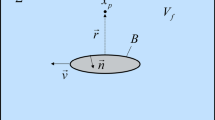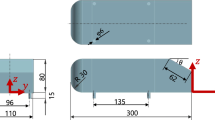Abstract
Numerical simulations were conducted to investigate the pressure fluctuations (PF) around a leading-edge slat, which was assumed to have close relationship with the far-field slat noise. The PF predicted that not only the reattachment region of the free shear layer shedding from the slat cusp, but the region close to the leading edge of main element were the crucial regions that radiated noise into far field. Proper orthogonal decomposition (POD) was applied to the PF around the slat. By checking the temporal sequence of vorticity distribution around the slat, the crucial flow features corresponding to the first four POD modes were examined, in particular the first mode was induced by the vortical structures convecting through the slat gap.
Access provided by Autonomous University of Puebla. Download conference paper PDF
Similar content being viewed by others
Keywords
- Proper Orthogonal Decomposition
- Pressure Fluctuation
- Vortical Structure
- Proper Orthogonal Decomposition Mode
- Vorticity Distribution
These keywords were added by machine and not by the authors. This process is experimental and the keywords may be updated as the learning algorithm improves.
1 Introduction
The noise generated from a leading-edge slat represents a complex aeroacoustic problem. Over the past several decades, extensive studies have been conducted with the aim of understanding of the underlying mechanisms of the slat noise generation. It is generally agreed that the slat noise is broadband in nature, with highest level appearing at a Strouhal (St) number of around 2 (based on the slat chord). In some cases, the noise can be superimposed by tonal components. Several models have been proposed to account for the broadband slat noise generation. For example, Molin and Roger (2000) attributed the broadband component to an interaction between turbulent structures in the slat cove region with the leading edge of the main element. Dobrzynski and Pott-Pollenske (2001) stated that the slat noise arose from the interaction between the vortices originating from the unsteadiness in the slat cove and the slat trailing edge. Another view regarding the slat noise generation is that discrete vortices are rolled up from the free shear layer shed from the slat cusp through the Kelvin–Helmholtz instability. These rolled up vortices then experience severe stretching and distortion. Then, when the unsteady flow is shed from the slat trailing edge, noise is generated (Dobrzynski 2010; Molin and Roger 2000; Konig et al. 2009). In this current work, first to obtain the flow properties around the slat, a delayed detached eddy simulation (DDES) was performed. The value distributions of the pressure fluctuations (PF) in the vicinity of the slat were calculated. Meanwhile, the regions which were in key responsibility for the far-field slat noise were predicted through the PF distribution. Proper orthogonal decomposition (POD) was applied to the PF around the slat. By checking the temporal sequence of vorticity distribution around the slat, the crucial flow features corresponding to the POD modes were deduced.
2 Geometric Model and Setup for Numerical Simulation
For a generic wing in a landing configuration, it is known that the leading-edge slat and trailing-edge flap are the main components of noise. To isolate the slat component of high lift device noise, tests were conducted with a two-element model (Fig. 1). The model used in this study had a RA16SC1 section. The deflection angle of the slat (δ s ) was set to 30°. The horizontal gap (o s ) and overlap (g s ) were respectively −2.4 and 2.7 % of the chord, in the stowed configuration. The main element chord (c m ) was 0.35 m and the slat chord was 0.088 m (c s ). The computational domain extended from −20 to 20 c m in both the x and y directions. An extension of 0.41 c s and 37 grid points was used in the spanwise direction. The entire three-dimensional domain consisted of 5 × 106 points. An incompressible S-A DDES technique, along with a second order temporal discretization was employed. Across all the solid surfaces no-slip boundary conditions were imposed. Periodic boundary conditions were employed across the spanwise boundaries of the computational domain. A dual time-stepping algorithm was used, with 20 subiterations within each time step of 7.14 × 10−4 flow time unit (time non-dimensionalised by c m /u ∞ ). The freestream velocity was set to 25 m/s, and the angle of attack (AOA) was set to 8°.
3 Results and Discussions
3.1 Pressure Fluctuations Around the Slat
Several studies had linked the slat noise sources with PF values around a slat. PF on or close to solid surface are known to play an important role in noise generation. Figure 2 shows the \( p_{\text{rms}}^{\prime } \) (root mean square of PF) around the slat. \( p_{\text{rms}}^{\prime } \) had high values not only in the reattachment region but also in the region close to the leading edge of the main element. The distributions pattern predicted that the dominant slat noise was generated from the two regions.
3.2 Modes of PF in Vicinity of Slat
To further investigate the behaviour of PF and the flow feature in the vicinity of the slat, POD technique was applied to the PF. The POD is a post-processing technique that takes a set of data and extracts basis functions. The technique was originally developed to identify the most energetic coherent structures contained in a turbulent flow. The POD calculation presented that the first four modes contributed to approximately 75 % of the total ‘energy’. Therefore, understanding the flow features corresponding to those modes will help to understand the processes involved in the production of slat noise.
As shown in Fig. 3a, the first mode, appearing in the wake of the trailing edge of slat and the region close to the leading edge of the main element, had the highest values of PF. The time history of PF at positions A and B (shown in Fig. 4) revealed a crucial feature, the PF at the two positions had identical magnitude but opposite phase. To gain insight into the flow feature corresponding to the first mode, the typical vorticity distribution around the slat at time τ 1 was examined (Fig. 5). From this figure, it can be observed that a large vortical structure was stretched by the mean flow through the slat gap. As the front part of the vortical structure approached the suction surface of main element, it altered the vorticity in the boundary layer above the main element surface. At the same time, a vortex was forced to shed from the trailing edge by the rear part of the vortical structure. It can be reasonably assumed that the rapid alternation of vorticity in the boundary layer arises the intense PF in the region close to the leading edge of main element, whilst the vortex shedding from the trailing edge leads to the PF in the wake of the slat trailing edge. By checking the temporal sequence of the vorticity distribution, it was shown that vortical structures were intermittently convected through the slat gap. The second mode (Fig. 3b) denotes that PF in region C and the reattachment region are spatially correlated. The second mode was similar to the conventional interpretation associated with the slat noise generation, which claims that the intense PF in the reattachment region results from that the turbulent free shear layer impinging on the slat cove surface. In addition, relatively high PF in the region C was assumed to result from the local flow acceleration.
The third mode (shown in Fig. 3c) was related to the PF in the reattachment region and slat region. By checking the temporal sequence of the vorticity distribution, two kinds of vortex interaction could be seen. The first is shown in Fig. 6a. As a vortex approached the reattachment region, it induced a vortex to be shed from the trailing edge. This shed vortex flowed towards the slat cove, rather than towards the wake of the trailing edge. Then, the vortex interacts with a succeeding vortex convected by the free shear layer. This second vortex interaction pattern is illustrated in Fig. 6b. Once a vortex convected by the free shear layer impinged on the slat cove surface, part of it was trapped in the circulation region. Subsequently, the trapped vortex interacts with a succeeding vortex convected by the free shear layer. These two kinds of vortex interactions are assumed to be the flow features corresponding to the third mode, because they occur at the same spatial position where the PF was high.
The fourth mode (Fig. 3d) indicated that PF in the reattachment region was correlated with the PF in the wake of the trailing edge. Two kinds of possible flow features can account for this mode pattern. The first is that as the circulation around the slat was altered, by the vortex convecting with the free shear layer, a vortex would be shed from the trailing edge of the slat due to the Kutta-Joukowski condition. The second flow feature is that the unsteady flow was shed from the slat trailing edge after the vortices impinged on the slat cove surface.
4 Summary
Numerical simulations were conducted to investigate the features, and possible mechanisms of generation, of slat noise. POD was applied on PF around the slat and the main flow features corresponding to the first four modes were discussed. The first mode was the outcome of vortical structures convecting through the slat gap. The second mode related to the flow accelerating near the slat gap and the vortex impinging on the slat cove surface. The third mode corresponded to complex vortex interaction. Finally, the fourth mode related to the unsteady flow shed from the slat trailing edge, or vortex shedding due to the Kutta-Joukowski condition.
References
Dobrzynski W (2010) Almost 40 years of airframe noise research: what did we achieve? J Aircr 47:353–367
Dobrzynski W, Pott-pollenske M (2001) Slat noise source studies for farfield noise prediction. In: Proceedings of 7th AIAA/CEAS aeroacoustics conference and exhibit, AIAA paper, Maastricht, Netherlands
Konig D, Koh SR, Schroder W, Meinke M (2009) Slat noise source identification. In: Proceedings of 30th AIAA aeroacoustics conference, AIAA paper, Miami, Florida
Molin N, Roger M (2000) The use of Amiet’s methods in predicting the noise from 2D high-lift devices. In: Proceedinngs of 6th AIAA/CEAS aeroacoustics conference, AIAA paper, Lahaina
Author information
Authors and Affiliations
Corresponding author
Editor information
Editors and Affiliations
Rights and permissions
Copyright information
© 2014 Springer-Verlag Berlin Heidelberg
About this paper
Cite this paper
Chen, P., Wang, X., Wen, Y. (2014). Modes of Pressure Fluctuations Around a Leading-Edge Slat. In: Zhou, Y., Liu, Y., Huang, L., Hodges, D. (eds) Fluid-Structure-Sound Interactions and Control. Lecture Notes in Mechanical Engineering. Springer, Berlin, Heidelberg. https://doi.org/10.1007/978-3-642-40371-2_32
Download citation
DOI: https://doi.org/10.1007/978-3-642-40371-2_32
Published:
Publisher Name: Springer, Berlin, Heidelberg
Print ISBN: 978-3-642-40370-5
Online ISBN: 978-3-642-40371-2
eBook Packages: EngineeringEngineering (R0)










